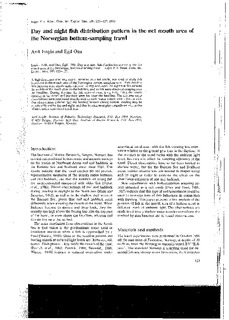| dc.contributor.author | Engås, Arill | |
| dc.contributor.author | Ona, Egil | |
| dc.date.accessioned | 2009-01-22T14:27:00Z | |
| dc.date.issued | 1990 | |
| dc.identifier.issn | 0074-4336 | |
| dc.identifier.uri | http://hdl.handle.net/11250/107975 | |
| dc.description | Int. Symp. on Fisheries Acoustics, Seattle, WA (USA), 22-26 Jun 1987 | en |
| dc.description.abstract | A high-frequency scanning sonar, mounted as a net sonde, was used to study fish behaviour in the mouth area of the Norwegian bottom-sampling trawl. Fish distribution patterns were significantly different by day and night. At night the fish entered the middle of the trawl, close to the bobbins, and no fish were observed escaping over the headline. During daytime the fish entered more irregularly, using the whole opening of the trawl, and haddock (Melanogrammus ) were lost over the headline. The daytime sonar observations were confirmed visually with an underwater vehicle with video camera. The observations indicate that the herding process during bottom trawling may be equally efficient by day and night, and that hearing must play a significant role in this process under non-visual conditions. | en |
| dc.format.extent | 437301 bytes | |
| dc.format.mimetype | application/pdf | |
| dc.language.iso | eng | en |
| dc.publisher | ICES | en |
| dc.title | Day and night fish distribution pattern in the net mouth area of the Norwegian bottom-sampling trawl | en |
| dc.type | Journal article | en |
| dc.type | Peer reviewed | |
| dc.subject.nsi | VDP::Agriculture and fishery disciplines: 900::Fisheries science: 920::Catch: 925 | |
| dc.subject.nsi | VDP::Agriculture and fishery disciplines: 900::Fisheries science: 920::Fisheries technology: 924 | |
| dc.source.pagenumber | s. 123-127 | en |
| dc.source.volume | 189 | en |
| dc.source.journal | Rapports et Procès-Verbaux des Réunions | en |
